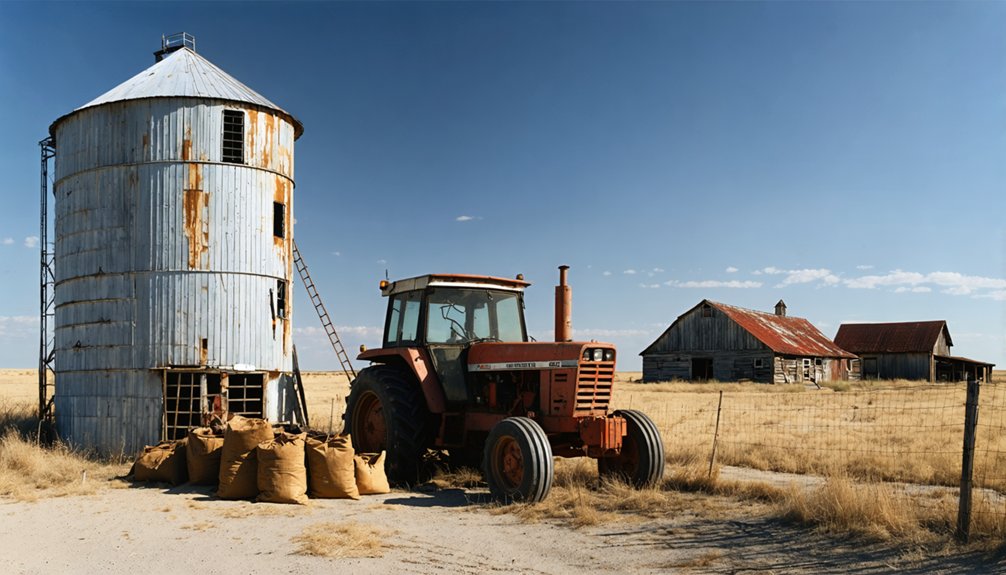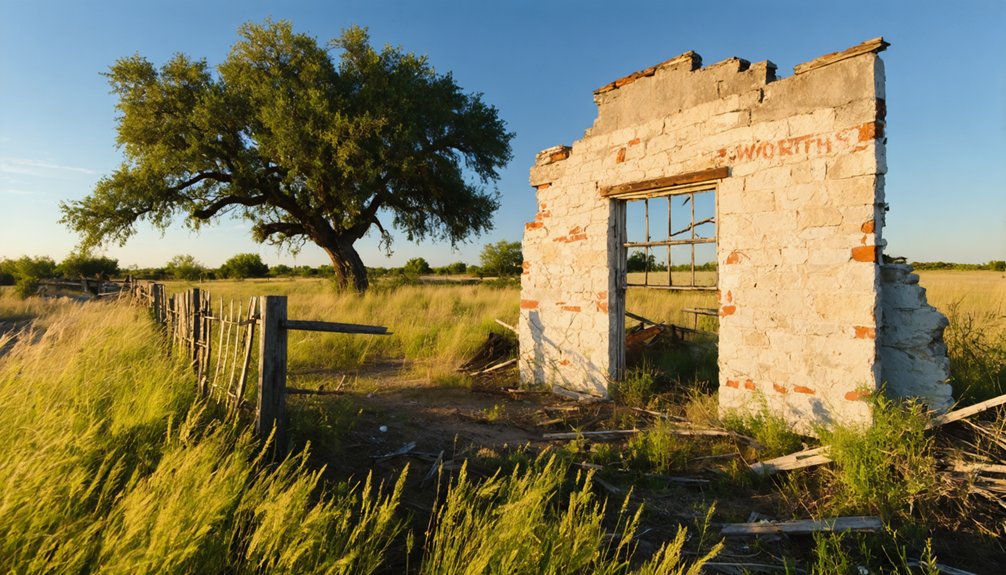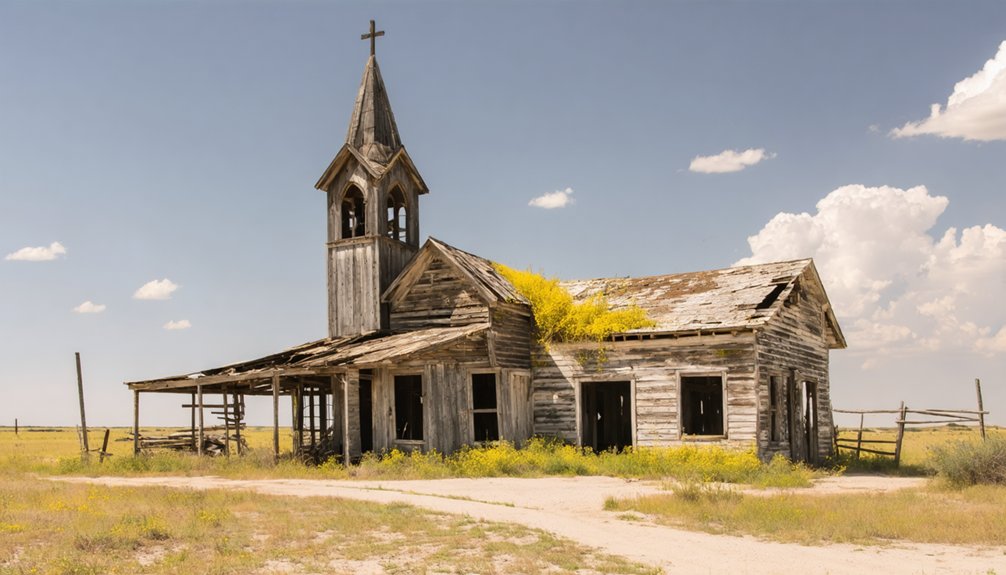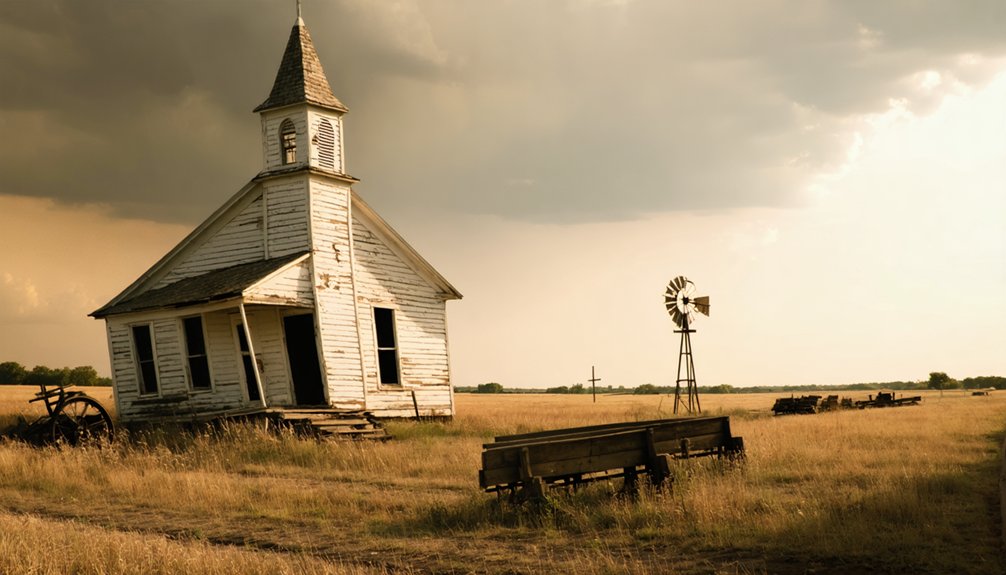You’ll find Epworth’s ghost town remnants in Texas, where Methodist minister Horatio Graves established the settlement in 1884. The community thrived briefly around agriculture and church life until railroad plans fell through, crushing hopes of becoming a commercial hub. After merging with Hale City in 1893 to form Hale Center, Epworth’s original site succumbed to drought and economic hardship. Its weathered fence posts and empty foundations tell a compelling story of frontier dreams and environmental challenges.
Key Takeaways
- Epworth was established in 1884 by Methodist minister Horatio Graves as an agricultural settlement with aspirations for rail connectivity.
- Failed railroad plans and severe droughts led to economic decline, forcing many settlers to abandon their farms and homes.
- The community merged with Hale City in 1893 to form Hale Center, marking the beginning of Epworth’s decline.
- Agricultural challenges, including soil degradation and water scarcity, made farming unsustainable and accelerated the town’s abandonment.
- Today, Epworth exists only through remnants like weathered fence posts, empty foundations, and an old cemetery in the Texas landscape.
Origins in Late 19th Century Texas
While many Texas frontier settlements struggled to take root in the late 19th century, Epworth’s story began with the establishment of its first post office, marking its formal recognition as a community.
Similar to the cotton farming economy that sustained nearby Cheapside, early settlers worked to build an agricultural foundation for their new town.
Much like Belle Plain’s educational center, Epworth had aspirations to become a hub of learning in its region.
In 1891, you’ll find that settlement patterns shifted when the post office moved several miles to establish “New Epworth,” reflecting the determination of early settlers to adapt and survive.
Despite efforts to demonstrate community resilience, Epworth faced the harsh realities of frontier life. The region’s persistent drought conditions proved insurmountable for the struggling settlement.
Railroad Dreams and Settlement Hopes
You’ll find Epworth’s story deeply intertwined with the ambitious railroad plans of the Texas and Pacific Railway and East Line & Red River Railroad, which promised to connect the settlement to major trade routes in late 19th century Texas.
Early settlers placed their economic hopes on these rail connections, anticipating that Epworth would grow into a bustling hub along the expanding rail network. The East Line & Red River Railroad initially aimed to extend its tracks to McKinney but construction stopped at Greenville in 1880.
When the railroad companies ultimately chose different routes and the promised rail lines never materialized, Epworth’s dreams of becoming a thriving commercial center began to fade. The Texas and Pacific Railway’s rapid expansion had reached 1,034 miles of track by the end of 1881, but none of this extensive network passed through Epworth.
Rail Plans Fall Through
Despite ambitious plans for transcontinental expansion, the Texas & Pacific Railway’s dreams of reaching San Diego from Texarkana faced major setbacks in the 1870s.
You’d have seen the railroad failures mount as the Panic of 1873 dried up financing, leaving countless settlement illusions shattered across Texas.
The ambitious plans required five new locomotives ordered from Baldwin Works to begin the journey west, but Jay Gould’s takeover in 1879 couldn’t salvage the original vision, as the line stopped at Sierra Blanca and never reached El Paso independently. General Grenville Dodge oversaw the engineering efforts as construction finally resumed.
- Empty graded railbeds stretching across vacant prairies
- Abandoned survey markers dotting the western landscape
- Half-finished railroad bridges standing as monuments to failed dreams
- Ghost towns emerging where promised rail lines never materialized
The harsh reality of financial constraints and competitive deals reshaped Texas’s railroad landscape, leaving many communities stranded without their promised connections to the outside world.
Early Settler Hopes Rise
The early 1880s brought fresh optimism to the Texas plains as Epworth took shape around a modest stage station and store near China Creek. Settler motivations centered on the promise of rail connectivity, which you’d find was a common thread driving community aspirations throughout the region.
Early arrivals envisioned Epworth becoming a bustling hub, where trains would transport their cattle and crops to distant markets. You’d have seen the enthusiasm build as railroad companies promoted settlement through free rides and festive celebrations. The Fort Worth and Denver Railway became a focal point of local development hopes. Much like the Sealy brothers of Galveston, local entrepreneurs invested heavily in railroad development.
The presence of fertile land near China Creek strengthened settlers’ hopes for agricultural success. Like nearby Harrold, Epworth’s residents anticipated rapid growth through the establishment of businesses, schools, and churches – all the hallmarks of a thriving frontier community.
Economic Dreams Fade Away
While railroad magnates Jay Gould and Collis P. Huntington battled over rail routes in western Texas, Epworth’s economic aspirations hung in the balance. The intense competition between their railways, coupled with the devastating Panic of 1873, crushed the community’s dreams of becoming a thriving commercial hub. The financial crisis delayed crucial railroad construction until late November 1881, when tracks finally began extending from Hodge Junction. The Houston and Galveston rail centers dominated early development, leaving smaller settlements to struggle for survival.
- Empty storefronts lined dusty streets where merchants once anticipated bustling trade.
- Abandoned construction sites stood as stark reminders of halted progress.
- Scattered homesteads remained isolated without the promised rail connectivity.
- Weather-worn survey stakes marked where tracks were meant to transform the landscape.
The shifting community dynamics reflected broader patterns across Texas, where towns lived or died by railroad access. When the rails bypassed Epworth, following routes determined by political influence and corporate deals, the settlement’s hopes of economic prosperity faded into the western horizon.
Life in Early Epworth Community
Life in early Epworth revolved around Methodist minister Horatio Graves, who established the settlement in 1884 as the first community within its county.
Methodist minister Horatio Graves shaped early Epworth’s identity as he founded this pioneering settlement, making history as the county’s first community.
You’d find the town’s community dynamics centered on the local church, which served as both a spiritual haven and the heart of social gatherings. Graves’ leadership touched every aspect of daily life, from establishing the post office to guiding moral and educational development.
If you’d visited Epworth then, you’d have encountered a small but determined population of settlers drawn by available land and religious fellowship.
While infrastructure remained basic, with minimal roads and simple housing, the community sustained itself through farming and livestock operations.
The post office’s presence marked a vital step in connecting these pioneers to the outside world.
Agricultural Challenges and Economic Struggles

Despite early optimism among Epworth’s farming families, severe environmental challenges began threatening the community’s agricultural foundation by the early 1900s.
You’d have witnessed the community’s agricultural resilience tested by devastating droughts, while soil depletion and harsh climate conditions steadily eroded crop yields. The town’s economic adaptation proved increasingly difficult as technological changes and market shifts transformed farming practices.
- Withered corn stalks standing abandoned in dusty fields as water sources ran dry
- Empty storefronts along main street as mechanization reduced labor needs
- Rusty farm equipment left behind when families could no longer sustain operations
- Weather-beaten farmhouses surrounded by untended fields as residents moved away
The combined impact of agricultural consolidation and transportation changes ultimately overwhelmed Epworth’s farming economy, leaving the once-vibrant community struggling to survive in Texas’s changing agricultural landscape.
Relationship With Hale City
You’ll find that Epworth and Hale City, established just two miles apart in 1891, initially operated as rival communities facing similar settlement challenges in central Hale County.
When both towns struggled with drought conditions and failed railroad prospects, their residents made the practical decision to merge their communities in 1893, forming what would become Hale Center.
The consolidation involved physically relocating buildings and homes from both original townsites to the new central location, demonstrating the communities’ willingness to overcome their rivalry for mutual survival.
While both Epworth and Hale City emerged as rival settlements in 1891, they soon found themselves confronting identical challenges that would ultimately forge their shared destiny.
Despite their initial settlement disputes, harsh environmental and economic realities forced community cooperation.
You’ll find that both towns struggled against severe drought conditions that crippled agricultural development, while the absence of railroad connections further isolated their economies.
- Scattered homesteads dotted the prairie landscape, connected by dirt trails and shared water sources
- Empty storefronts stood as silent witnesses to failing businesses
- Lone windmills creaked against the Texas wind, pumping precious water from deep wells
- Weather-beaten structures housed the remaining residents who refused to abandon their dreams
Consolidation Through Adversity
As economic hardships and environmental challenges mounted in 1893, the rival settlements of Epworth and Hale City made the pragmatic decision to merge into a single community.
You’ll find remarkable community resilience in how residents physically relocated their buildings and homes to establish Hale Center, strategically positioned in the county’s center.
The historical significance of this merger lies not just in the physical consolidation, but in how two competing towns united to guarantee their survival. Rather than constructing new buildings from scratch, they transported existing structures to the new location, demonstrating resourcefulness in the face of adversity.
The establishment of Hale Center’s post office marked official recognition of this bold consolidation, though the town wouldn’t see substantial growth until the Santa Fe Railroad’s arrival in 1909.
Building Relocation Patterns
When harsh drought conditions and failed railroad prospects threatened both settlements in 1893, residents of Hale City and Epworth commenced on an ambitious building relocation project.
You’ll find that the building techniques and relocation logistics were quite remarkable for their time, as entire structures were physically transported to establish the new town of Hale Center. The communities joined forces, pooling their resources to move homes, businesses, and public buildings approximately two miles to their chosen central location.
- Structures were lifted from their foundations and loaded onto horse-drawn wagons
- Teams of oxen and men worked together to transport buildings across the plains
- Buildings remained largely intact during the move to preserve valuable materials
- Structures were repositioned strategically to form Hale Center’s initial layout
The Great Migration to Hale Center
Through the merging of rival towns Hale City and Epworth in 1893, Hale Center emerged as a focal point for migration in Texas’ agricultural heartland.
You’ll find migrant experiences shaped by cotton farming opportunities and the arrival of the Santa Fe Depot in 1911, which connected settlers to broader commercial networks.
The community’s resilience showed in its rapid growth, with settlers like Reverend Horatio Graves from New York joining Southern migrants in building a diverse agricultural society.
You can trace this expansion through the First Baptist Church’s membership, which grew from 63 to 463 members between 1911 and 1935.
The promise of farmland, combined with technological advances like steam plows and grain drills, drew families seeking new opportunities in this evolving frontier community.
What Remains Today

Despite its once-thriving presence, modern-day Epworth stands largely reclaimed by nature, with only scattered structural remnants marking its former existence. Under current conditions, you’ll find most original buildings reduced to foundations and rubble, while surrounding farmland and pastures have overtaken the town’s former footprint.
The site’s historical significance persists through possible cemetery grounds and historical markers, though you’ll need landowner permission to explore the privately-owned property.
- Weathered building ruins stand roofless against the Texas sky, serving as silent witnesses to the past
- Old foundations and cairns peek through native vegetation that’s steadily reclaimed the land
- Overgrown paths and minimal signage lead to what remains of the former community
- A possible historical marker or cemetery offers the only formal recognition of Epworth’s existence
Legacy in Texas Ghost Town History
As a tribute to early Texas settlement patterns, Epworth’s legacy endures through its role in shaping Hale County’s development during the late 19th century.
You’ll find its historical significance woven into the broader narrative of pioneer resilience and community dynamics that characterized early West Texas settlements.
When you examine Epworth’s story, you’ll see how it exemplifies the common challenges that faced many frontier towns – from railroad speculation to economic pressures that ultimately led to its merger with Hale City in 1893.
The town’s transformation into part of Hale Center reflects the adaptability of early Texas settlers and their pragmatic approach to survival.
Today, Epworth serves as a compelling case study of how settlement clusters evolved, merged, and sometimes disappeared in response to the changing landscape of the American frontier.
Environmental Forces Behind Abandonment

You’ll find that Epworth faced intensifying agricultural hardships as droughts swept through Texas Hill Country, straining an already fragile farming economy.
The harsh climate shifts mirror patterns seen across Texas ghost towns, where environmental pressures combined with resource depletion to make cultivation increasingly difficult.
These shifting agricultural conditions ultimately undermined the town’s sustainability, as farmers struggled to maintain viable crop yields in the deteriorating environmental conditions.
Harsh Drought Impact
When severe droughts struck Texas from 1949 to 1957, Epworth faced devastating environmental pressures that ultimately contributed to its abandonment.
You’ll find that drought repercussions hit this community hard, receiving only half the normal rainfall and making agriculture nearly impossible. Despite initial community resilience, the harsh conditions forced residents to make difficult choices about staying or leaving.
- Parched fields turned barren as crop yields plummeted, devastating local farming families.
- Water sources dried up, making daily survival increasingly challenging for residents.
- Buildings had to be physically relocated as families sought more viable locations.
- Community bonds fractured as neighbors scattered to different areas with better prospects.
The environmental stress proved too severe, and like many Texas towns of that era, Epworth’s population dispersed, leaving behind another ghost town in the drought-stricken landscape.
Shifting Agricultural Conditions
Beyond the immediate impact of the drought years, deeper agricultural challenges sealed Epworth’s fate. You’d have seen the devastating effects of over-farming, as years of poor crop rotation and inadequate soil conservation stripped the land of its vitality.
The community’s failure to adopt sustainable farming practices led to severe topsoil erosion and declining fertility. Water management became increasingly difficult as both surface and groundwater sources diminished.
You would’ve noticed how larger agribusinesses, equipped with agricultural innovation, gradually replaced family farms. Without modern infrastructure and facing mounting competition, Epworth’s farmers couldn’t maintain their livelihoods.
The shift to monoculture farming further weakened the soil’s robustness, while irregular rainfall patterns and pest outbreaks dealt additional blows to community resilience. The town’s agricultural foundation simply couldn’t sustain itself under these compounding pressures.
Lessons From a Lost Community
The decline of Epworth, Texas offers valuable insights into the fragile nature of rural settlement sustainability in late 19th-century America.
You’ll find that community resilience often hinged on factors beyond local control, while agricultural innovation alone couldn’t guarantee survival. When railroad plans fell through and drought struck, even the most determined settlers had to adapt or relocate.
- Weathered fence posts stand as silent sentinels where hopeful farmers once planted their dreams
- Empty foundations mark where family homes once echoed with life
- Overgrown fields whisper tales of failed harvests and harsh seasons
- Forgotten cemetery stones tell stories of those who stayed until the end
The town’s eventual merger with Hale Center demonstrates how communities sometimes had to sacrifice independence for survival, a pattern that shaped Texas’s rural landscape.
Frequently Asked Questions
Were There Any Notable Crimes or Lawlessness Incidents in Epworth?
Unlike 27% of Texas ghost towns with documented criminal pasts, you won’t find any recorded crime incidents or law enforcement actions in Epworth’s history. Its decline stemmed from economic factors, not lawlessness.
What Was the Peak Population of Epworth Before Its Decline?
You’ll find no exact peak demographics recorded, but based on comparable ghost towns and historical context, Epworth’s population likely peaked at 300-400 residents before its population decline and eventual absorption into Hale Center.
Did Any Famous Historical Figures Ever Visit or Live in Epworth?
As quiet as a forgotten whisper, you won’t find any documented famous visitors or historical connections to Epworth. Historical records don’t indicate any notable figures ever living in or visiting this settlement.
What Businesses and Services Existed in Epworth During Its Brief Existence?
You’d have found business types ranging from coal mining operations to brick manufacturing, plus service offerings including an opera house, 200-room hotel, ice plant, schools, churches, stores, and saloons.
Were There Any Schools or Churches Established in Epworth?
You’ll find church significance was clear with Epworth’s Methodist founding, but details of specific buildings aren’t documented. School history is uncertain, though it’s likely education was informal or sought elsewhere.
References
- https://mix941kmxj.com/see-how-two-texas-ghost-towns-battled-for-the-county-and-lost/
- https://www.tshaonline.org/handbook/entries/hale-city-tx
- https://www.youtube.com/watch?v=phjUE19A8HM
- https://mix931fm.com/12-east-texas-ghost-towns/
- https://authentictexas.com/texas-ghost-towns/
- https://jamesbigleyranches.com/general/texas-ghost-towns/
- https://en.wikipedia.org/wiki/List_of_ghost_towns_in_Texas
- https://www.hmdb.org/m.asp?m=91328
- https://texashillcountry.com/3-great-texas-ghost-towns-investigate/
- https://theforgottensouth.com/cheapside-texas-ghost-town-history/



